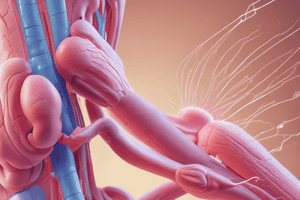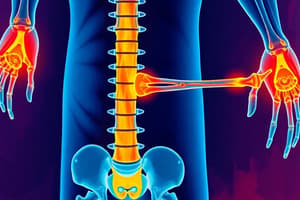Podcast
Questions and Answers
Which of the following is a modifiable risk factor for gout?
Which of the following is a modifiable risk factor for gout?
- Older age
- Obesity (correct)
- Family history
- Ethnicity
What is the male to female ratio for those at risk of gout?
What is the male to female ratio for those at risk of gout?
- 5:1
- 20:1 (correct)
- 1:1
- 10:1
Which of the following factors can influence urate balance in the body?
Which of the following factors can influence urate balance in the body?
- Stress
- Extreme exercise
- Dietary factors
- Chronic renal impairment (correct)
Which of these lifestyle choices is most likely to act as a trigger for the development of gout?
Which of these lifestyle choices is most likely to act as a trigger for the development of gout?
How long can it take for gout to develop after exposure to triggers?
How long can it take for gout to develop after exposure to triggers?
What is gouty arthritis primarily classified as?
What is gouty arthritis primarily classified as?
Which group has the highest prevalence of gouty arthritis?
Which group has the highest prevalence of gouty arthritis?
In which decade of life does the peak onset of gouty arthritis typically occur?
In which decade of life does the peak onset of gouty arthritis typically occur?
What mechanism is primarily responsible for hyperuricemia in gouty arthritis?
What mechanism is primarily responsible for hyperuricemia in gouty arthritis?
How likely is a patient to experience a second attack of gouty arthritis within a year after the first?
How likely is a patient to experience a second attack of gouty arthritis within a year after the first?
Which condition is NOT a potential cause of hyperuricemia leading to gouty arthritis?
Which condition is NOT a potential cause of hyperuricemia leading to gouty arthritis?
Which type of joint is most commonly affected by gouty arthritis?
Which type of joint is most commonly affected by gouty arthritis?
What is the acute phase duration of gouty arthritis symptoms?
What is the acute phase duration of gouty arthritis symptoms?
Which treatment option is a non-pharmacological management for gout?
Which treatment option is a non-pharmacological management for gout?
Which of the following is NOT a clinical feature of gouty arthritis?
Which of the following is NOT a clinical feature of gouty arthritis?
What common time does gouty arthritis often occur?
What common time does gouty arthritis often occur?
During an acute gout attack, when does the maximum intensity of pain typically occur?
During an acute gout attack, when does the maximum intensity of pain typically occur?
Which of the following management strategies is focused specifically on patient education?
Which of the following management strategies is focused specifically on patient education?
What is the main characteristic of asymptomatic hyperuricaemia in comparison to gout?
What is the main characteristic of asymptomatic hyperuricaemia in comparison to gout?
Which condition is NOT part of the chronic pathology of gout?
Which condition is NOT part of the chronic pathology of gout?
When do gouty tophi typically appear after the initial gouty attack?
When do gouty tophi typically appear after the initial gouty attack?
What is the trail of symptoms between acute gouty attacks referred to as?
What is the trail of symptoms between acute gouty attacks referred to as?
What symptom may occur during a polyarticular attack of gouty arthritis?
What symptom may occur during a polyarticular attack of gouty arthritis?
What tissue structures can be involved in gout pathology?
What tissue structures can be involved in gout pathology?
Which of the following describes an aspect of chronic gout?
Which of the following describes an aspect of chronic gout?
What is the main characteristic of acute gouty arthritis?
What is the main characteristic of acute gouty arthritis?
What type of joint disease is primarily classified as a degenerative joint disease?
What type of joint disease is primarily classified as a degenerative joint disease?
Which of the following conditions is characterized by symmetrical joint involvement?
Which of the following conditions is characterized by symmetrical joint involvement?
Which condition primarily affects weight-bearing joints?
Which condition primarily affects weight-bearing joints?
How does morning stiffness differ among osteoarthritis, rheumatoid arthritis, and gout?
How does morning stiffness differ among osteoarthritis, rheumatoid arthritis, and gout?
What is a distinguishing feature of gout compared to other types of arthritis?
What is a distinguishing feature of gout compared to other types of arthritis?
Which demographic is most likely to experience rheumatoid arthritis?
Which demographic is most likely to experience rheumatoid arthritis?
Which characteristic of osteoarthritis differentiates it from rheumatoid arthritis?
Which characteristic of osteoarthritis differentiates it from rheumatoid arthritis?
In which condition is joint involvement typically monoarticular?
In which condition is joint involvement typically monoarticular?
Flashcards are hidden until you start studying
Study Notes
Gouty Arthritis Overview
- Definition: Inflammatory arthritis caused by monosodium urate (MSU) crystal deposition in joints due to hyperuricemia (elevated uric acid levels).
- Hyperuricemia: A serum uric acid level above 6.8 mg/dL is a key feature.
Epidemiology
- Prevalence: Affects 1-4% of the population; most common inflammatory joint disease in men.
- Age Factor: Peak onset typically occurs in the 50s, with prevalence plateauing after age 70.
- Recurrence: Approximately 60% experience a second attack within one year; 80% within three years.
- High Serum Urate: Levels exceeding 9 mg/dL increase the likelihood of flare-ups by three times within 12 months.
Etiology and Risk Factors
- Causes of Hyperuricemia: Over-production or under-excretion of urate can lead to gout.
- Triggers: Include chronic kidney disease, hypertension, certain medications, alcoholism, obesity, and extreme exercise.
- Risk Factors: Include older age, male sex (20:1 ratio), genetic predisposition, and dietary habits (purine-rich foods).
- Modifiable risks: Hypertension, hyperlipidemia, diabetes mellitus, obesity, and alcohol consumption.
Pathology
- Stages of Gout:
- Asymptomatic hyperuricemia: High urate without symptoms.
- Acute gouty arthritis: Characterized by sudden, severe pain.
- Intercritical gout: Time between acute attacks, can include persistent pain.
- Tophaceous gout: Involves solid urate crystals leading to joint damage; tophi appear around 12 years post-initial attack.
Clinical Features
- Symptom onset: Symptoms develop rapidly, often within 24 hours, marked by severe pain, swelling, erythema, and increased temperature.
- Articular Characteristics: Typically monoarticular, often affecting the big toe (1st MTPJ), with acute attacks often occurring at night.
- Duration: Acute phases usually last less than 10 days, alternating with long periods of remission.
Diagnosis
- Urate Levels: Serum urate levels above threshold indicate gout but only a small percentage with elevated uric acid experience gout symptoms.
- Differential Diagnosis (DDx): Includes septic arthritis, osteoarthritis, trauma, and cellulitis to rule out other conditions.
Management
- Acute Treatment: Focuses on resolving pain and inflammation within 10 days using pharmacological methods.
- Chronic Management: Involves patient education on lifestyle modifications, dietary advice, and possibly pharmacotherapy for urate-lowering.
- Non-Pharmacological: Rest, ice, and splinting recommended to relieve symptoms during acute attacks.
Role of Physiotherapists
- Physiotherapists play a crucial role in managing gout, emphasizing education, physical activity guidance, and pain management strategies.
- Comparative Aspects:
- Gout differs from osteoarthritis (degenerative) and rheumatoid arthritis (autoimmune) in terms of pathology, symmetry, and onset of symptoms.
- Key differences:
- OA is non-inflammatory and affects weight-bearing joints; RA is symmetrical and affects peripheral joints; gout is inflammatory and monoarticular.
Studying That Suits You
Use AI to generate personalized quizzes and flashcards to suit your learning preferences.





